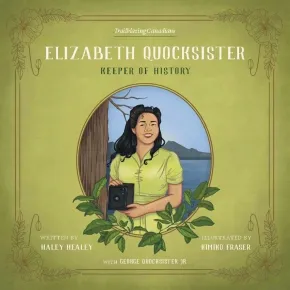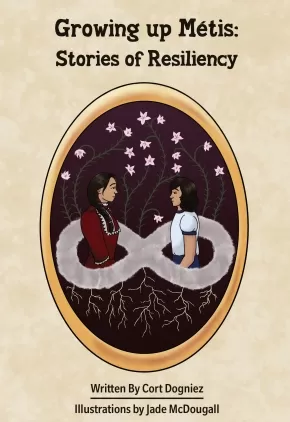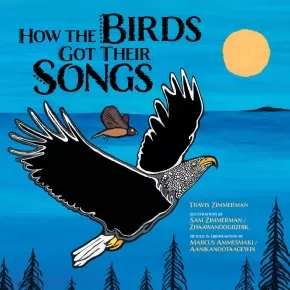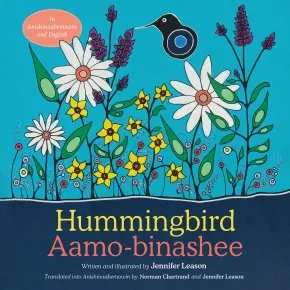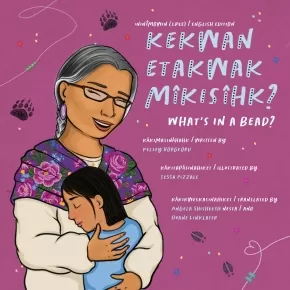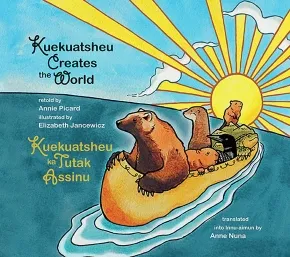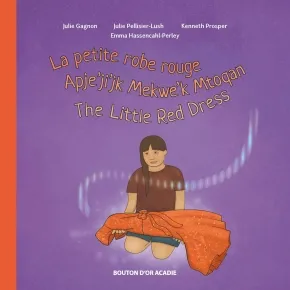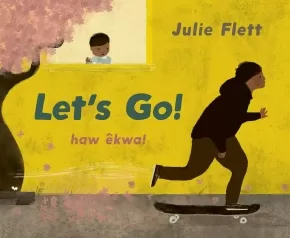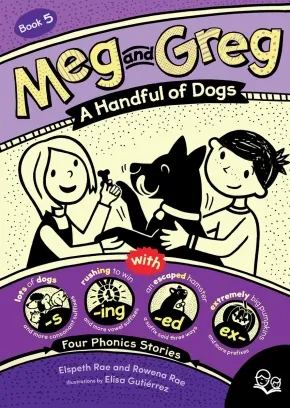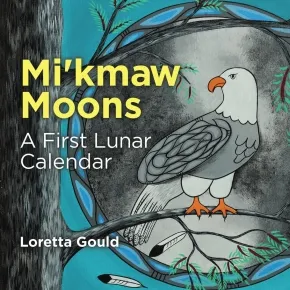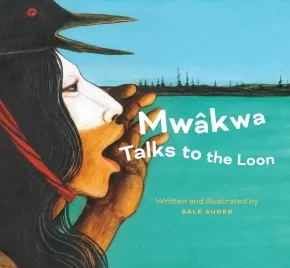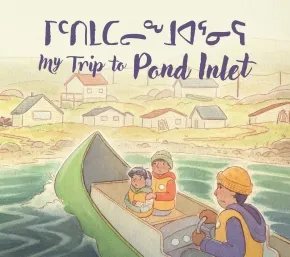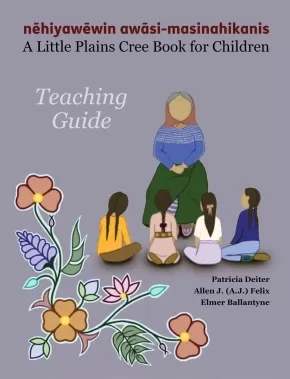
Language
91
-
105
of
422 Results;
Sort By
Go To
of 29
Elizabeth Quocksister: Keeper of History (PB)
$12.95
Artists:
Format:
Paperback
Text Content Territories:
Indigenous Canadian; First Nations; Kwakwaka'wakw (Kwakiutl); Da'naxda'xw Awaetlala;
ISBN / Barcode: 9781772034851
Synopsis:
Synopsis:
The uplifting true story of Elizabeth Quocksister, a strong Indigenous woman and community leader, who dedicated her life to protecting her language and cultural traditions.
Elizabeth Quocksister (1925–81) had many roles in her life. She was a cultural teacher, a community leader, a dancer, a nurse, a photographer, a residential school survivor, and a mother of ten. Born on the Da’naxda’xw Nation on Knight Inlet on the central coast of British Columbia, Elizabeth spoke fluent Kwak’wala and proudly celebrated her Kwakwaka’wakw culture at a time when the Canadian government actively discouraged Indigenous traditions and the speaking of Indigenous languages. She cared for community members in need and saved many children from the horrors of residential school. She chronicled the daily lives, important events, and changing times of her community through photography—preserving her people’s history and culture for future generations. This inspiring picture book is a beautiful tribute to a proud Indigenous woman whose name deserves to be well-known throughout her community and beyond.
Educator Information
Recommended for ages 4 to 8.
Additional Information
32 pages | 9.00" x 9.00" | Paperback
Growing up Métis : Stories of Resiliency
$17.50
Artists:
Format:
Paperback
Text Content Territories:
Indigenous Canadian; Métis;
ISBN / Barcode: 978-1-988011-34-9
Synopsis:
Synopsis:
Cort Dogniez’s Growing up Métis: Stories of Resiliency is the second installment of his historical fiction series that began with Road to La Prairie Ronde. In two separate, but connected fictionalized stories, Cort delves into the lives of two of his foremothers: his great-grandmother, Josephine Gariepy and his grandmother, Clara Dumont when they were young. While highlighting the dispossession and marginalization of his ancestors following the 1885 Resistance, Cort deftly weaves Métis culture through these two stories with a positive “focus on nicknames, faith, storytelling, and a resilient spirit.”
Jade McDougall’s beautiful illustrations brings these poignant, coming of age stories to life. Growing up Métis: Stories of Resiliency includes Michif and Cree glossaries to reflect Josephine and Clara’s first languages as well as guide questions for educators to explore the stories and Métis culture in depth with their students.
Educator & Series Information
Recommended by the publisher for ages 9+.
This book is the second installment in the historical fiction series that began with Road to La Prairie Ronde.
Additional Information
85 Pages | 14 cm x 20.3 cm | Paperback
How the Birds Got Their Songs
$25.00
Format:
Hardcover
Text Content Territories:
Indigenous American; Native American; Anishinaabeg; Ojibwe (Chippewa); Grand Portage Band of Lake Superior Chippewa;
ISBN / Barcode: 9781681342856
Synopsis:
Synopsis:
The Great Spirit challenges all the birds to a contest, and the gift of birdsong is born! This traditional story, told in both English and Ojibwe, explains bird behavior and where humans should go to hear the prettiest of birdsongs.
When Mother Earth was very young and the Great Spirit had created all the beings, he noticed how quiet everything was. As he walked about the earth, listening to the sounds of the animals and the wind and the waters, some birds flying by caught his eye. He knew immediately what he needed to do.
The Great Spirit held a contest so that each bird could earn the song that was just right for its species. He called together all the birds, from the smallest sparrow to the largest hawk, and told them the plan. Each would fly as high in the sky as it could, and when it returned to Mother Earth it would receive its song.
Eagle was certain his strong wings would help him fly highest of all and earn the prettiest song. But he did not know that, while the Great Spirit was talking, the tiny hermit thrush had snuggled into eagle's feathers to take a nap.
All the birds flew and flew, higher and higher, each descending when it was time to return—and each receiving its own special song. But which bird flew the highest? Which one received the prettiest song?
This treasured story, handed down through author Travis Zimmerman's family, features traditional knowledge from the Grand Portage Band of Lake Superior Chippewa. Grand Portage descendant Sam Zimmerman's vibrant illustrations showcase his stylized artistry and deep appreciation for feathered creatures. Marcus Ammesmaki's retelling in Ojibwemowin brings the story full circle, encouraging language learners to explore this age-old depiction of our natural world—and inviting all readers to cherish the gift of birdsong.
Educator Information
Recommended for ages 3 to 7.
Dual-Language: English and Ojibwe.
Retold in Ojibwemowin by Marcus Ammesmaki / Aanikanootaagewin. Marcus is a K/1 teacher at Waadookodaading Ojibwe Language Institute in Hayward, Wisconsin.
Additional Information
32 pages | 10.00" x 10.00" | Hardcover
Hummingbird / Aamo-binashee
$21.95
Artists:
Format:
Hardcover
Text Content Territories:
Indigenous Canadian; First Nations; Anishinaabeg;
ISBN / Barcode: 9781459837140
Synopsis:
Synopsis:
You never walk alone.
Remember the hummingbird's teachings. Remember you are loved.
Kokum warned us to watch out for one another. If we weren't careful, Windigo would eat us. But one night, alone in the darkness, I felt its breath on my neck. Windigo's lies crept into my heart, and I believed them. When we lose connection with others, we lose ourselves, and Windigo's darkness grows and spreads.
In this deeply emotional and beautifully illustrated picture book, the ancestors send a hummingbird to a child lost in Windigo’s darkness. Its teachings of resilience, love and connection bring the child home and remind us that our ancestors are always watching and can help us find our way if we only ask.
This bilingual book includes full text in both English and Anishinaabemowin.
Educator Information
Recommended for ages 6 to 8.
Fountas & Pinnell Text Level Gradient: U
Lexile measure: 520L
Guided Reading Level: U
Dual-Language: English and Anishinaabemowin
There are many dialects fo Anishinaabemowin, and this book presents a phonetic spelling of the language as learned by the author and co-translator in Duck Bay, northeastern Manitoba. This dialect is sometimes referred to as Western Ojibwa, Nakawemowin, Saulteaux or Plains Ojibwa. Translated by Norman Chartrand and Jennifer Leason.
This beautifully illustrated story expresses hope, healing and reclamation of Indigenous strength and identity in the wake of oppression and trauma.
This book is included in the Indigenous Books for Schools database from the Association of Book Publishers of BC. It is recommended for Grades 1 to 3 for Art, English Language Arts, and Social Studies.
Additional Information
32 pages | 8.00" x 8.00" | Hardcover
It Bears Repeating
$23.99
Artists:
Format:
Hardcover
Text Content Territories:
Indigenous Canadian; Inuit;
ISBN / Barcode: 9781774880555
Synopsis:
Synopsis:
This beautifully crafted picture book celebrates one of the world's most awesome animals: the polar bear. Evocative but simple text by award-winning musician and artist Tanya Tagaq is accompanied by striking art in this classic counting book.
Beginning with 1 proud polar bear standing tall and ending with 10 bears waving goodbye, this delightful counting book shows polar bears in all their forms: slippery and fast, crafty and cool, hungry and proud. Tanya has created a story meant to be read aloud, incorporating simple Inuktitut words and using her keen ear for the musical sound of language.
This book is joyful, powerful, clever and striking — much like the bears who sniff, slide, swim, hunt, play and dance through its pages. And when you get to the last page, you won't be able to resist going back to repeat the journey!
Educator Information
Recommended for ages 3 to 7.
Concepts: Counting & Numbers; Animals - Polar Bears.
This book is meant to be read aloud and incorporates simple Inuktitut words.
Additional Information
24 pages | 10.50" x 9.00"
It Is Good to Live in Beautiful Arctic Bay
$16.95
Artists:
Format:
Paperback
Text Content Territories:
Indigenous Canadian; Inuit;
Grade Levels: Preschool; Kindergarten;
ISBN / Barcode: 9781774507933
Synopsis:
Synopsis:
Lucy loves living in Arctic Bay. There are so many things to do in each season! In the winter during "the great darkness," Lucy likes watching the northern lights. She is always excited to welcome the sun back in the spring. In the summer, Lucy can't wait to go blueberry picking, camping, and eat pissi. Follow along with Lucy as she takes readers through the seasons and shares all her favourite things about living in beautiful Arctic Bay.
Educator & Series Information
Recommended for ages 3 to 5.
Dual-Language: English and Inuktitut.
This book is part of the Community Connections series.
Additional Information
29 pages | 9.00" x 8.00" | Paperback
kekwan etakwak mîkisîhk / What’s in a Bead?
$21.95
Artists:
Format:
Hardcover
Text Content Territories:
Indigenous Canadian; First Nations; Anishinaabeg; Cree (Nehiyawak);
ISBN / Barcode: 9781772603675
Synopsis:
Synopsis:
There are many stories in a bead. We must listen to the stories they tell us.
Tessa loves how her grandmother always smells of campfire stories. Mom says it’s because Kohkom spends her days sewing beautiful beads onto smoked hides. Inspired, Tessa asks Kohkom to teach her beading, but first she must listen and learn about the many stories held in a bead.
A celebration of Cree craftsmanship, language, and learning. The loving exchange of knowledge between Tessa and her Kohkom will be familiar to many children. Readers will learn that different Indigenous communities have different beadwork techniques, and that this traditional art form is alive and thriving today.
Reviews
"The story is a beautiful look into the importance of beading in our communities and the ways that this art practice ties us together as families and communities." — Nancy Cooper, First Nations Consultant for the Southern Ontario Library Services and coordinator for First Nation Communities Read
Educator Information
Recommended for ages 6 to 8.
This dual language edition contains the story in both Ininîmowin (Cree, N-dialect) and English.
Translators: Duane Linklater & Angela Shisheesh
Duane is Omaskêko Ininiwak and currently lives in North Bay, Ontario. He earned a Master of Fine Arts from Bard College and a Bachelor of Native Studies with a focus in Cree language from the University of Alberta. Linklater is lifelong learner of the Cree language and credits the many Elders, including his kohkom Agnes Hunter, for teaching and sharing the language.
Angela is a Cree translator at Ojibway & Cree Cultural Centre based in Timmins, Ontario
An English-only version is available: What's in a Bead?
This book is available in French: Le pouvoir d'une perle
Additional Information
24 pages | 8.50" x 8.50" | Hardcover
Kuekuatsheu Creates the World / Kuekuatsheu ka Tutak Assinu: (Sheshatshiu dialect)
$24.99
Artists:
Format:
Hardcover
ISBN / Barcode: 9781998802203
Synopsis:
Synopsis:
The story of how the world came to be on the turtle's back can be found in Indigenous cultures throughout North America/Turtle Island. It has many variations. This moving version of the tale—a story of resilience, sacrifice, and friendship—is one that Annie Picard was often told as a child by her maternal grandmother while they lived in nutshimit (on the land) in the Labrador/Quebec peninsula. Picard's lovely re-telling of this traditional Innu story of how little muskrat makes an enormous sacrifice to help the wolverine and his other friends rebuild the world after a great flood is brought vividly to life by Elizabeth Jancewicz's stunning illustrations.
Educator Information
Recommended for ages 4 to 8.
Bilingual: English and Innu-aimun.
Translation into Innu-aimun by Anne Nuna.
Additional Information
36 Pages | 9" x 8" | Hardcover | 2nd Edition
La petite robe rouge / Apje'ji'jk Mekwe'k Mtoqan / The Little Red Dress
$15.95
Format:
Paperback
Text Content Territories:
Indigenous Canadian; First Nations; Mi'kmaq;
ISBN / Barcode: 9782897503482
Synopsis:
Synopsis:
Sakari loves to rummage through her grandmother's house, but she doesn't know what's hidden in the woven basket her nukumi keeps in the attic. Then, one day, she sees her nukumi in tears by the open basket, holding a photo album with poems and photos that Sakari has never seen. This prompts the older woman to tell her the story of her younger sister who disappeared shortly after graduating high school. Sakari will help her nukumi to free herself from this heavy secret and allow the spirit of the missing young woman to fly away in peace.
This trilingual book, in English, French, and Mi'kmaq, is an excellent introduction to Red Dress Day, which aims to raise awareness for Missing and Murdered Indigenous Women and Girls.
Educator Information
The publisher recommends this book as an all-ages picture book.
Trilingual: French, Mi'kmaq, and English
Additional Information
32 pages | 8.50" x 8.50" | Paperback
Let's Go! haw êkwa
$23.95
Artists:
Format:
Hardcover
Text Content Territories:
Indigenous Canadian; First Nations; Cree (Nehiyawak);
ISBN / Barcode: 9781771646109
Synopsis:
Synopsis:
An extraordinary book that celebrates skateboarding, family, and community, from beloved artist and author Julie Flett, a winner of the New York Times / New York Public Library Best Illustrated Children’s Book Award.
Every day, a little boy watches kids pass by on skateboards, and dreams of joining them. One day, his mother brings a surprise: her old skateboard, just for him! haw êkwa! Let’s go! Together, they practice on the sidewalk, at the park, in Auntie’s yard—everywhere. But when it comes time to try the skatepark, the skateboarders crash down like a waterfall. Can he find the confidence to join them?
Let’s Go! features:
- A glossary of Cree words featured in the book, and a Cree refrain (haw êkwa!) repeated throughout
- A note to the reader from Julie Flett about her inspiration for the story
This fun and touching story is a tribute to family, friendship, and perseverance. Julie Flett’s renowned art and powerful text shows a community of support is all around, ready to help each other… go!
Reviews
“Beautifully highlights the value of perseverance along with the joy of skateboarding.”—Horn Book, STARRED Review
“Extraordinary…. A fun read from start to finish, "Let's Go!" is especially and unreservedly recommended as a choice pick for family, daycare center, preschool, elementary school, and community library Self-Esteem and Family Life picture book collections for ages 3-8.”—Midwest Book Review
“Masterful, simple, powerful….a must-read for anyone who skateboards or wants to — or doesn’t.”—Amina Chaudri, Booklist
“Using onomatopoeic language to capture the sounds of the sport, Cree-Métis creator Flett (We All Play) shows the hard work and investment of time that goes into both learning a new skill and becoming ‘a part of something—/ and myself.’”—Publishers Weekly, STARRED review
Educator Information
Recommended for ages 3 to 8.
Curriculum Connections: Sports / Indigenous Languages / Community / Goal-Setting / Risk-Taking / Self-Awareness / Self-Confidence
This book is available in French: On y va!
Recommended in the Indigenous Books for Schools catalogue as a valuable resource for English Language Arts, Art, and Physical and Health Education in kindergarten to grade 3.
Additional Information
44 pages | 11.00" x 9.00" | Hardcover
Meg and Greg: A Handful of Dogs
$16.95
Artists:
Format:
Paperback
ISBN / Barcode: 9781459838239
Synopsis:
Synopsis:
A decodable book featuring four phonics stories for striving readers, with special features to help children with dyslexia or other language-based learning difficulties find reading success.
Meg and Greg are back to school and ready for fall fun! Join Meg, Greg and friends as they plan an event for dogs at the fall fair, solve challenging clues in a scavenger hunt, complete their planned science-fair project and look after excitable kindergarteners at the pumpkin patch.
Meg and Greg: A Handful of Dogs is the fifth book in the Meg and Greg series designed for shared reading between a child learning to read and an experienced reader. The four stories inside introduce different types of suffixes and prefixes (consonant suffixes -ful -ly -ment -s, vowel suffixes -en -er -es -est -ing -y, the suffix -ed and prefixes de- dis- ex- in- pre- re- un-) and the spelling rules for adding them to base words. In addition to the familiar comic-style kids’ pages, Book 5 features new highly controlled and decodable prose pages to gently increase the amount of text that readers experience and to provide even more opportunities to practice the reading skills previously introduced in Meg and Greg Books 1–4!
Educator & Series Information
Recommended for ages 6 to 9.
This book includes features to accommodate struggling or dyslexic readers, such as comic-book-style illustrations, a dyslexia-friendly typeface with ample spacing and shaded paper to reduce contrast between text and paper—all of which make this series more accessible.
Targeted at struggling readers ages six to nine has a wide appeal to ELL readers, reluctant readers and at-level readers alike with its engaging and age-appropriate plots and low reading level that doesn’t demoralize or stigmatize struggling readers.
This is the fifth book in the Orca Two Read series, designed for shared reading between a child learning to or struggling to read and an experienced reader. All of the stories have special features to help a child with dyslexia or another language-based learning difficulty find reading success.
Additional Information
160 pages | 5.87" x 8.25" | Paperback
Mi'kmaw Moons: A First Lunar Calendar (BB)
$16.95
Artists:
Format:
Board Book
Text Content Territories:
Indigenous Canadian; First Nations; Mi'kmaq;
Grade Levels: Preschool; Kindergarten;
ISBN / Barcode: 9781459507456
Synopsis:
Synopsis:
This board book presents the months of the Mi’kmaw lunar calendar to very young children and their parents. Mi’kmaw artist Loretta Gould’s art illustrates each of the 12 Mi’kmaw moons through the changing seasons in Mi’kma’ki. Each month is named after events in the natural world – from Snow Blinding Time through Frogs Croaking Time and Berry Ripening Time. Each month’s illustration is accompanied by its name in Mi’kmaw and English.
Loretta Gould’s art, first published in Mi’kmaw Moons: A First Lunar Calendar has won high praise from reviewers, and the book has received numerous awards.
Educator Information
For ages 2 to 5.
Includes names of the months in English and Mi'kmaw.
This is the board book version of Mi'kmaw Moons: The Seasons in Mi'kma'ki.
Additional Information
6.53" x 6.53" | Board Book
Mwâkwa Talks to the Loon: A Cree Story for Children - 2nd Edition
$12.95
Format:
Paperback
Text Content Territories:
Indigenous Canadian; First Nations; Cree (Nehiyawak);
ISBN / Barcode: 9781772034882
Synopsis:
Synopsis:
The award-winning story of a young Cree man blessed with the skills of a great hunter, who learns not to take his talents for granted.
Kayâs is a young Cree man who is blessed with a Gift that makes him a talented hunter. He knows the ways of the Beings he hunts and can even talk with them in their own languages. But when he becomes proud and takes his abilities for granted, he loses his gift, and the People grow hungry.
With the help of the Elders and the Beings that inhabit the water, Kayâs learns that in order to live a life of success, fulfillment and peace, he must cherish and respect the talents and skills he has been given.
Illustrated with Dale Auger's powerful, insightful paintings, Mwâkwa Talks to the Loon introduces readers to the basics of life in a Cree village. A glossary with a pronunciation guide to the many Cree words and phrases used in the story is included.
Awards
- The 1st edition was the winner of the Aboriginal Children's Book of the Year Award, 2006 Anskohk Aboriginal Literature Festival and Book Awards
Educator Information
Recommended Ages: 6-9.
Additional Information
32 pages | 10.00" x 9.25" | Paperback | 2nd Edition
My Trip to Pond Inlet
$16.95
Artists:
Format:
Paperback
Text Content Territories:
Indigenous Canadian; Inuit;
ISBN / Barcode: 9781774507728
Synopsis:
Synopsis:
One rainy day, Solomon is playing inside with his sister. Their mom is cooking polar bear meat in a big pot of water. Suddenly, he trips and burns his arm in the pot of boiling water! The burn is so bad that he must travel to the health centre in the neighbouring community of Pond Inlet. Solomon has to stay in Pond Inlet until his arm heals. Even though Solomon misses his home, he likes playing with the other kids at the health centre and exploring the new and exciting community of Pond Inlet.
Educator & Series Information
Recommended for ages 5 to 7.
In My Trip to Pond Inlet children learn about the responsibility of being safe around hot water and taking care of themselves after an injury.
Dual-Language: English and Inuktitut
This book is part of the Community Connections series.
Additional Information
40 pages | 9.00" x 10.00" | Paperback
nēhiyawēwin awāsi-masinahikanis: A Little Plains Cree Book for Children—Teaching Guide
$74.95
Format:
Coil Bound
Text Content Territories:
Indigenous Canadian; First Nations; Cree (Nehiyawak); Plains Cree;
Reading Level: N/A
ISBN / Barcode: 9781778690273
Synopsis:
Synopsis:
A Little Plains Cree Book for Children—Teaching Guide contains lesson plans, student assignments, and other helpful information for teaching the Plains Cree language—a companion to nēhiyawēwin awāsimasinahikanis: A Little Plains Cree Book for Children: A Reference for Teaching the Plains Cree Language, the content of which focuses on terms familiar to the First Nations Cree people of Saskatchewan and follows curriculum for Kindergarten to Grade 12.
Educator Information
Find the companion resource here: A Little Plains Cree Book for Children: A Reference for Teaching the Plains Cree Language
A colouring book companion is here: A Little Plains Cree Colouring Book: Plains Cree People
Additional Information
128 pages | 8.50" x 11.00" | Spiral Bound
Sort By
Go To
of 29

